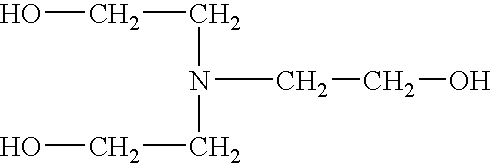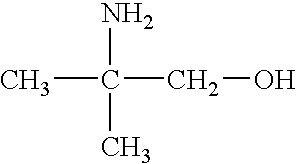Pyrithione biocides enhanced by zinc metal ions and organic amines
a biocide and zinc metal technology, applied in the field of pyrithione biocides, can solve the problems of limited commercial product pyrithione or its salts, and low biocidal efficacy of compounds, and achieve the effect of enhancing the biocidal
- Summary
- Abstract
- Description
- Claims
- Application Information
AI Technical Summary
Benefits of technology
Problems solved by technology
Method used
Image
Examples
examples 1-40
Efficacy of Mixtures of Sodium Pyrithione, ZnCl2, and Amines Against Microorganisms in Metalworking Fluids
[0138]Autoclaved 250 ml Erylenmeyer flasks with cheesecloth stoppers were arranged and into each flask was added 100 ml of one of the following diluted (1:20) metalworking fluid solutions: (1) soluble oil, (2) semi-synthetic fluid, or (3) synthetic fluid. Each of these fluids was designed to mimic commercially available soluble, semisynthetic and synthetic oils available from manufacturers.
[0139]The soluble oil was made from the following ingredients:
[0140]
100 SUS naphthenic petroleum base stock82.5%62% active sodium sulfonate11.0%oleic acid1.5%triethanolamine (TEA)1.0%methyl tallowate3.0%glycol ether1.0%
[0141]The Semi-Synthetic fluid was made from the following ingredients:
[0142]
100 SUS naphthenic petroleum base stock5.0%62% sodium sulfonate10.0%TEA15.0%Oleic acid15.0%carboxylic acid type corrosion inhibitor10.0%Water45.0%
[0143]The Synthetic Concentrate fluid was made from the ...
examples 41-51
Biocidal Efficacy of a Mixture of Sodium Pyrithione, ZnCl2, and Amines Against Free-Living Microorganisms and Biofilm Associated Microorganisms in Metalworking Fluid
[0150]Two five gallon glass aquarium tanks were disinfected with bleach and set up to simulate recirculating metalworking fluid systems. One aquarium pump was attached to each tank as a means to recirculate fluid through the tank. To provide sampling surfaces for biofilm growth, stainless steel washer coupons (1.2 cm2 surface area) and polycarbonate disc coupons (3.8 cm2 surface area) were attached to glass slide coupon holders with double stick carpet tape. Two steel and polycarbonate coupons were placed on each holder. 12.5 liters of dilute (1:20) semi-synthetic metalworking fluid was added to each tank.
[0151]Tank 1 served as an untreated control. Mixture D (16% NaPT, 2% ZnCl2, 20% monoethanolamine, 20% 3-amino-1-propanol) was added to tank 2 to a final concentration of 1250 PPM which yielded final active concentration...
example 52
Biocidal Efficacy of a Mixture of Sodium Pyrithione, ZnCl2, an Amine, and a Formaldehyde Releasing Biocide Against Microorganisms in Metalworking Fluids
[0155]Experiments were performed to compare the biocidal efficacy of mixtures of sodium pyrithione, ZnCl2, monoethanolamine, and hexahydro-1,3,5-tris(2-hydroxyethyl)-s-triazine (a formaldehyde releasing agent) with mixtures of sodium pyrithione and hexahydro-1,3,5-tris(2-hydroxyethyl)-s-triazine in metalworking fluids.
[0156]Sterile glass culture tubes (16 mm×150 mm) containing 3 ml of 5% soluble oil MWF or 5% semi-synthetic metalworking fluid were set up. To the tubes, 40% sodium pyrithione, 78.5% hexahydro-1,3,5-tris(2-hydroxyethyl)-s-triazine, or Mixture A (10% sodium pyrithione, 1.8% ZnCl2 and 60.5% monoethanolamine) were added in appropriate amounts to create various mixtures of the biocides and controls for each of the biocides. Bacteria and fungi were added to each tube to total final concentrations of 107 bacteria / ml and 105 f...
PUM
| Property | Measurement | Unit |
|---|---|---|
| surface area | aaaaa | aaaaa |
| surface area | aaaaa | aaaaa |
| temperature | aaaaa | aaaaa |
Abstract
Description
Claims
Application Information
 Login to View More
Login to View More - R&D
- Intellectual Property
- Life Sciences
- Materials
- Tech Scout
- Unparalleled Data Quality
- Higher Quality Content
- 60% Fewer Hallucinations
Browse by: Latest US Patents, China's latest patents, Technical Efficacy Thesaurus, Application Domain, Technology Topic, Popular Technical Reports.
© 2025 PatSnap. All rights reserved.Legal|Privacy policy|Modern Slavery Act Transparency Statement|Sitemap|About US| Contact US: help@patsnap.com



